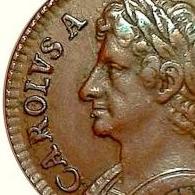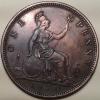-
Posts
1,509 -
Joined
-
Last visited
-
Days Won
51
Content Type
Profiles
Forums
Events
Downloads
Store
Gallery
Articles
Everything posted by Michael-Roo
-
Hi Clive. Not round (as you can see) so: 11mm wide diameter. 9mm narrow diameter. My digi scales have a graduation of 0.1g. It reads 0.3g!
-
I have an 1870 wide date penny. This is the Michael Gouby reverse C. Thirteen teeth from the centre of the 1 to the centre of the 0 (His normal width date being 12 teeth. Narrow width date 11 teeth). How scarce is mine compared with the normal variety? Also: Spink list 1870 as obv. 6 rev.G. The accompanying notes state obv.6 always displays a prominent flaw on the top stop of the colon after D at the end of the legend. Mine doesn't seem to have this flaw. Any thoughts?
-
Thank you Geordie. The other possibility (?) is Spink 1912A. I see that one does display smaller annulets. What do you think?
-
I've tried to get a sharper photo of the obverse (attached). Difficult to get a sharp image of such a tiny coin….
-
Amulets? My apologies. Annulets….
-
-

Henry III pennies, part the second…..
Michael-Roo replied to Michael-Roo's topic in British Hammered
Thanks again for the information Clive. No. Not a job lot. I buy hammered now and then. Not my main area of interest, but I do feel they serve as nice contrast to all the copper and tin. I ave a tiny hammered farthing which needs identifying. I'll post after writing this. -
Here's a nice one…. George V and Queen Mary's visit to Bidston Mill, Wirral, in March 1914 (not far from us). Crown sized medal in copper. Strong EF. Good to have the original ribbon still attached.
-

Henry III pennies, part the second…..
Michael-Roo replied to Michael-Roo's topic in British Hammered
Thank you! Anything rare or interesting included? -
-
Hi all. I have four Henry III pennies. I'm rubbish at reading the reverses of these. Can you tell me which mints/moneyers they are? Two with sceptre attached here. Two without sceptres to follow. Thank you!
-

Unusual 50p piece.
Michael-Roo replied to Michael-Roo's topic in British Coin Related Discussions & Enquiries
Another found in change many years ago…. Normal in all respects, apart from the tiny 'R4' deeply punched into the obverse field. Any ideas? -

Unusual 50p piece.
Michael-Roo replied to Michael-Roo's topic in British Coin Related Discussions & Enquiries
13.3g -
I found this in my loose change around 25 years ago and its been sitting in my oddments box ever since. Strangely formed and curved smooth edge. Post mint tampering?
-

Old Time Dealers-Reminising
Michael-Roo replied to Colin88's topic in British Coin Related Discussions & Enquiries
-

Old Time Dealers-Reminising
Michael-Roo replied to Colin88's topic in British Coin Related Discussions & Enquiries
Regarding R&L Coins of Blackpool: I found this article in an August 1967 copy of Coin Monthly I have. The past is another country….. Page two to follow -
With my thanks to Mr. Wayne G Sayles of Gainesville: Copper 1 is a modern fake of an Alexander the Great type. Copper 2 is a Seleukid bronze of Antiochus VIII 121-96 BC The silver is a Roman Republican denarius. Numa Pompilius and Ancus Marcius 88 BC.
-
Much appreciated. Thank you. Here's another you all may find interesting. Charles I half groat. mm R in circle. The condition isn't great but, as you'll clearly see, the king's name is entered as 'arolvs'. There isn't an empty area where one would expect to find the letter C. Arolvs fills the available space.
-
Thanks both. Hi Rob. I have the coin in front of me now. I must confess, I don't see any evidence of double striking in the obverse field. Also: would multiple strikes result in Iacobus being entered twice yet leaving all other parts of the inscription as normal?
-
Hello all. Your thoughts on this coin would be most welcome. A James I shilling, mm lis. The king's name looks to have been entered twice. Not simply double struck, but at two distinct positions at the beginning of the legend. I know it is not uncommon to find hammered coins which display 'blundered' legends, but this error is something entirely different? All other parts of both obverse and reverse legends are as they should be. Any ideas concerning rarity value? Cheers.
-
There is indeed something below that exergue line. Unfortunately, even under high magnification, I can't for the life of me work out what it might be. I was hoping the obverse conjoined busts might be something which would give a clue to its identity. Clearly pre Roman. The tall head gear sported by the rider of the two horses on the reverse might also be something to consider. I guess best thing would be to show it to a few people in the Classics and Archaeology dept. of our Uni.
-
PS: The flan (silver coin) is noticeably thick for its 17mm size. Its also worth noting how the bust in the foreground is somewhat smaller than that behind.
-
You're quite right. Obviously not a 'W'. Apologies for my sloppy Greek. Its the silver coin I find most intriguing. I've owned this for 30 years or so, and yet still its the one which I've never been able to place.


























